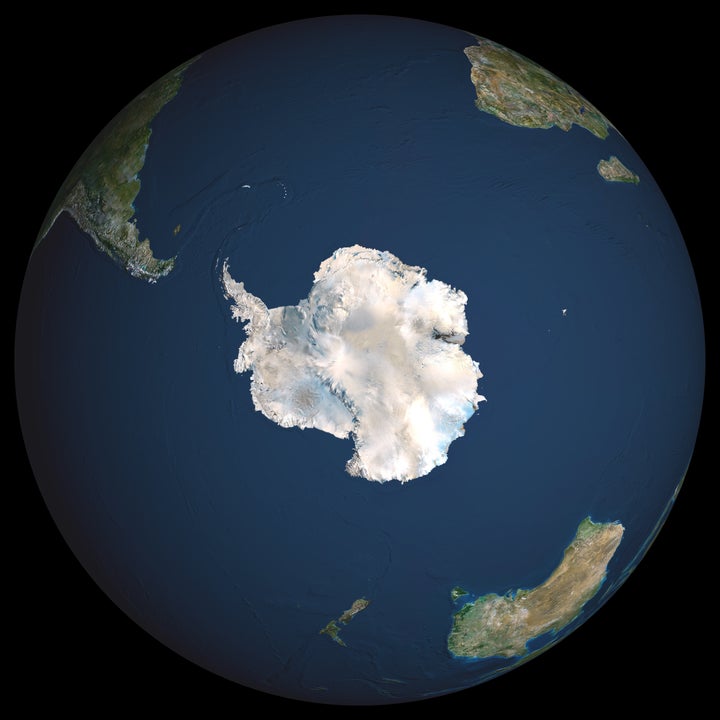
The melting of Antarctic ice shelves could double in the next 35 years and lead to ice shelf collapse by the end of the century if fossil fuel consumption continues at the current rate, according to a new study published Monday in the journal Nature Geoscience.
Floating ice shelves, which act as a natural "door stop" by slowing land-based ice sheet melt into the ocean, are affected by both air and ocean temperatures, explained Luke Trusel, the study’s lead author and a postdoctoral scholar at Woods Hole Oceanographic Institution in Massachusetts. As air and ocean temperatures rise due to climate change, the shelves melt at an accelerating rate.
Melting ice shelves alone do not contribute significantly to sea level rise, but if those shelves collapse and ice from glaciers and ice sheets then melts in the ocean, that would create a much more significant issue, Trusel said. Previous studies have estimated that the melting of the Antarctic ice sheets could contribute as much as 200 feet to global sea level rise.
Trusel said the study looks at how Antarctic ice shelf melt changes over time in response to climate change. "What we see is that melt kind of behaves like a threshold system -- either an ice shelf is pretty cold and not much melting is happening at all, or if you warm it up even a little bit, you exponentially increase the melt rate," he said.
That current threshold, Trusel said, is somewhere around the average Antarctic Peninsula summertime temperature of -3 degrees Celsius (about 26 degrees Fahrenheit). The peninsula is the northernmost part of the continent.
Trusel said temperatures have exceeded this key threshold over the past few decades on the Antarctic Peninsula, and the progressive warming from north to south has caused ice shelves to collapse.
"Essentially, this is a region where the climate has warmed at rates faster than the global average,” he said.

Using satellite observations of ice surface melt and climate model simulations, researchers projected two scenarios through the year 2100: One with high levels of greenhouse gas emissions that are similar to or more intense than current levels, and another scenario with "intermediate," or reduced, emissions levels.
With reduced emissions levels, ice shelf melt would continue, but wouldn't reach the projected threshold where ice sheets become unstable. But under current or accelerated levels of greenhouse gas emissions, temperatures could warm enough to critically erode those ice shelves.
Trusel's co-authors looked at the peninsula’s history and evidence of past changes in its ice shelves, and applied those projections across all of Antarctica.
Melting ice can cause water to pool on the surface, Trusel said. When that happens, rather than reflecting solar energy as ice would, the meltwater absorbs energy from the sun, and that warmer water trickles into cracks and crevices in the ice, causing further melt.
"Ice sheets just do not like water. Not on top, not below, not from the ocean -- unless the ocean layer is very cold. Water on ice means that the ice is very unstable,” said Ted Scambos, the lead scientist for the science team at the National Snow and Ice Data Center, in an email to The Huffington Post. He wasn't involved in the study published Monday.
"This study shows that we can expect much larger areas of flooded ice in the future," Scambos said, noting that variables like snowfall can complicate projections. “An ice sheet area with a lot of annual snowfall can tolerate a lot more melting before these factors affecting stability come into play."

Ocean warming is the biggest concern when it comes to changing ice shelves, Trusel said. After examining how much melting occurs every day and making some extrapolations, he said that researchers found "a number of ice shelves are due to disintegrate just due to ocean warming."
"If we add on to this bottom-up melting and top-down melting -- which is what we’re projecting -- that raises future concern," Trusel said.
He also noted that the study makes projections based on known trends and conditions, but does not predict how the disintegration of ice shelves might impact global sea levels (or how much trouble awaits New Orleans and Miami, for example).
Despite the study's alarming projections on potential ice shelf collapse, Trusel said there are two ways of looking at it.
"You could interpret this as bad news, or you could interpret it as good news -- in that we have this really clear control on the climate of Antarctica," Trusel said. "And because of that control, we ultimately determine what path we’re on."
Even if the world reduces its greenhouse gas emissions, there will still be an increase in ice melt -- just not to the point where humans will have to worry about ice sheet stability, Trusel explained.
Adopting energy policies and other practices like reducing deforestation, all of which reduce carbon emissions, are central to the issue, Trusel said.
"It’s up to us what path we go down. There’s a silver lining here.”

